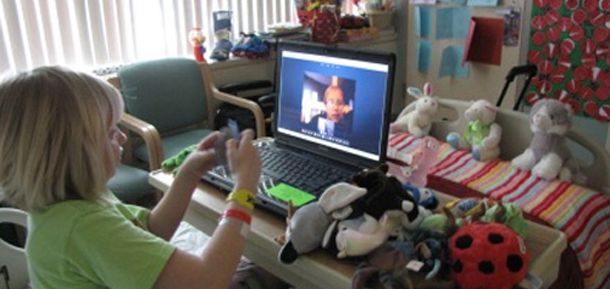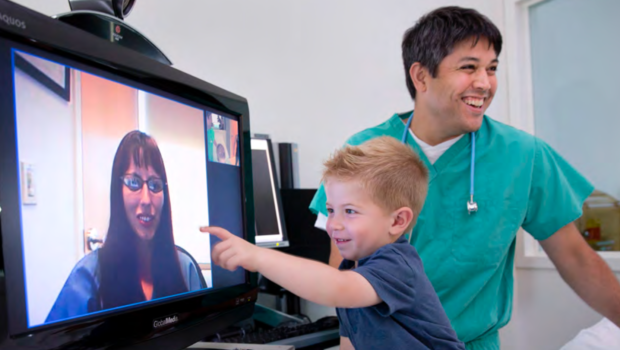Telemedicine for children with disabilities in remote communities
UC Davis Department of Pediatrics has received a $2 million, five-year grant from the Agency for Healthcare Research and Quality (AHRQ) to fund a new telemedicine program for children in remote communities. The School-Based Tele-Physiatry Assistance for Rehabilitative and Therapeutic Services (STARS) program will provide critical physiatry care for kids with cerebral palsy, spina bifida, spinal cord injuries and other disabilities.

UC Davis Pediatric Telemedicine Program. UC Davis Children’s Hospital
Tricia Tomiyoshi, University of California-Davis November 15, 2017
Sacramento CA — Physiatry is a branch of medicine centered on non-surgical physical medicine and rehabilitation, aiming to restore functional ability and quality of life to those with physical impairments. The team believes the program will close gaps in care, improve quality of life for affected children and save money.
“The goal of the STARS program is to broaden our reach,” said Loren Davidson, associate clinical professor and chief of pediatric rehabilitation. “We’re geographically limited based on the distance from the medical center and how many staff we have to send out. We’re trying to bridge the provider gap through telemedicine, trying to reach these underserved communities.”

Pediatric Telehealth Colloquium, UC Davis Conference Center October 23-24, 2017
Children with severe disabilities receive free, coordinated care through California Children’s Services’ Medical Therapy Program. During school-based clinics, visiting clinicians examine each child to determine the best therapeutic approaches to prevent complications and reduce suffering, prescribing physical therapy and medications, as well as devices, such as orthotics, braces and wheelchairs.
The system breaks down, however, for kids in remote communities. There are only a limited number of physiatrists who can travel long distances. When a physiatrist is unavailable, other physicians are enlisted to conduct clinics. These substitutes may lack the appropriate training to provide comprehensive care.
“One of our goals is to look at hip surveillance screening,” said Davidson. “Kids with cerebral palsy are at high risk for hip dislocation. The best treatment is to identify these problems early, before the hip completely dislocates – an orthopedic surgeon can keep the hip in. But when the doc providing guidance is not a rehab doc, and not affiliated with the pediatric orthopedists conducting surveillance, the screening doesn’t get done.”
In addition, sending physiatrists to remote communities is expensive and reduces their ability to provide care. Every hour on the road is time spent not treating patients.

In this photo from Livecare, a specially trained medical assistant uses an exam camera to capture images of a patient’s throat while a doctor (on screen in the background) observes remotely. Mercedes Leung, Vancouver Sun
“In some faraway counties, they can’t even hire a physician, they just tell the family they have to drive,” said James Marcin, chief of pediatric critical care medicine and director of the pediatric telemedicine program at UC Davis Children’s Hospital. “It’s a huge burden on children and their families.”
To remedy this, the STARS program will test whether telemedicine is an effective way to provide physiatry care. The program will install secure tele-conferencing equipment in schools in San Joaquin, Butte, Mendocino, Lodi and Fresno counties. Davidson and other physiatrists will remotely guide screening and write the appropriate prescriptions and referrals. The group believes they can provide better care for more children and prevent many of the complications associated with these conditions.
“The efficiencies gained with telemedicine, the medical direction we can provide – it’s a potential game-changer,” said Marcin.
In addition to providing care, the grant will also support research to determine which approaches provide the greatest benefit for kids and their families. The study will examine three cohorts: physiatrists providing care in person; non-physiatrists providing care in person; and physiatrists using telemedicine. The group will assess whether telemedicine improves quality of care, increases patient-centeredness and reduces costs.
But most importantly, the group hopes these efforts will help them reach children who need access to the best possible care.
“The hardest thing to see is different outcomes based on how close patients live to a children’s hospital,” said Davidson. “That should not be a determining factor.”
Source UC Davis
| The power of video chat for one UC Davis pediatric patient. UC Davis Family-Link Program provides iPads and laptops so patients can video chat with family members, while they are hospitalized. UC Davis Children’s Hospital. Youtube Nov 7, 2014 |
Also see
Telehealth Overview: The Reality Check, Please in Managed Care
Using Phones to Connect Children to Health Care in The New York Times
Could Telehealth Technologies Improve Pediatric Care? mHealth Intelligence
Telemedicine Is Wide-Reaching But Doesn’t Always Replace Doctor’s Touch California Healthline
UC Davis study finds videoconferencing with family, friends lowers stress for pediatric patients in UC Davis Children’s Hospital
Docs update screen advice, say toddlers can FaceTime in USA Today
Modern-day house calls come to remote BC town in Vancouver Sun
